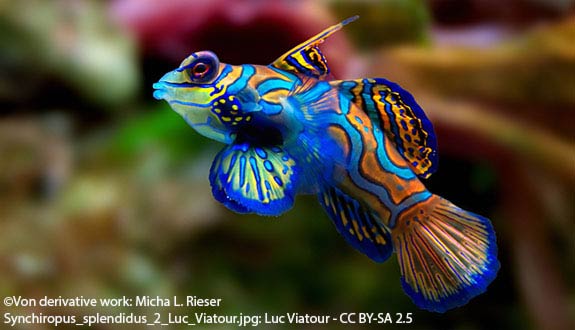

Alternative species (click on the thumbnail to see the card)
Names
Scientific name
Synchiropus-splendidus
Pterosynchiropus splendidus
Callionymus splendidus
Neosynchiropus splendidus
Common name
Mandarin dragonet
Mandarinfish
Dragonnet mandarin
Origin

Origin: Western Pacific Ocean (Philippines, Australia)
Natural habitat: always found near the substratum of coral reefs, in shallow depths (between 0 and 20 m / 0 and 66 feet).
Dimorphism

Males have a longer first radius of the dorsal fin than females. This one is stockier, round and also smaller.
Group

Callionymidae
Volume

100 L / 22 Imp Gal / 26 US Gal
Parameters

T°: 23 to 26°C or 73 to 79°F
pH: 8 to 8.5
Density: 1021 to 1026
Difficulty

Hard
Size

7cm (2.8")
Longevity

5 to 9 years
Living zone

Depth
Individuals
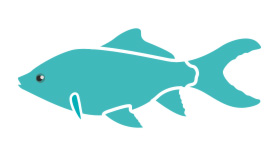
1 or harem
Food
How to feed the Mandarin dragonet?
Food
How to feed the Mandarin dragonet?
We have classified this species as a hard to maintain fish because of its diet.
The Mandarin is a planktonophagous fish. In nature, it feeds on microscopic animals called animalcules (which make up zooplankton) living on rocks. It is also not averse to good phytoplankton (plant life)!
In aquariums, feeding correctly can be tricky. First of all, be aware that most Mandarins will never eat freeze-dried food, which is not very appreciated by the species.
If your aquarium is more than 6 to 8 months old, and it is not too "clean" or sanitized, the Mandarin will find a first source of food in the decor: colonies of zooplankton and phytoplankton should already be installed. But how do they appear? This microfauna is essentially made up of larvae from living organisms in your aquarium (when it is well balanced): worms, echinoderms, gastropods, copepods, amphipods (including gammares), decapods, etc... The Mandarin feeds on the microscopic larvae of its species. This can be destabilizing for an aquarist, because in the end, he can never see what his fish eats or feed it directly. Instead, his role will be to ensure that these microscopic larvae are in sufficient quantity to satisfy the Mandarin's appetite. To do this, maintain your microfauna by making regular intakes of live zooplankton. If your Mandarin has enough prey adapted to its very particular diet, you will not see it eating "big" prey.
In fact, many aquarists observe their Mandarin eating larger prey, such as artemia (which are part of the macro fauna, not the micro fauna). In reality, they will adopt this type of food because they have no choice, and zooplanktonic larvae are running out. However, this type of diet is not suitable, and your fish may suffer from severe digestive problems over time. They will die "suddenly" and prematurely, but this will have been the result of malnutrition throughout their lives.
Finally, note that in an environment rich in microfauna, the Mandarin moves relatively little: it will carefully peck its meal of the day in a relatively small area. If it moves quickly from one place to another, it is looking for its food! It is then in a situation of food suffering, it is more than just the time to feed on live zooplankton!
Behavior
What kind of behavior does the Mandarin dragonet have?
Behavior
What kind of behavior does the Mandarin dragonet have?
Its funny swimming gives the impression that it flies more than it swims! This is due to its constantly moving pectoral fins. It moves little by little, stopping often and changing direction frequently, like a butterfly.
It spends most of its time looking for food, pecking at the scenery all day long. It moves frequently but always in a calm environment and close to the ground. It rarely swims in open water.
Peaceful and calm, it does not pose any particular cohabitation problems. Indeed, it ignores the other occupants of the aquarium, and the other fishes do it well!
Cohabitation
Who can live with the Mandarin dragonet?
Cohabitation
Who can live with the Mandarin dragonet?
The first rule to observe is that you should never introduce two male Mandarin Fish into an aquarium! Fortunately, sexual dimorphism is easy and you will be able to recognize the males easily. Indeed, males do not tolerate the presence of a rival: they will fight until the death of one of them in most cases! Pair maintenance can result in failure depending on the configuration of the host aquarium, as Mandarin fish tend to be aggressive with all members of their species. This is why it is advisable to maintain this fish either alone or in a harem consisting of one male for every two females (females are calmer).
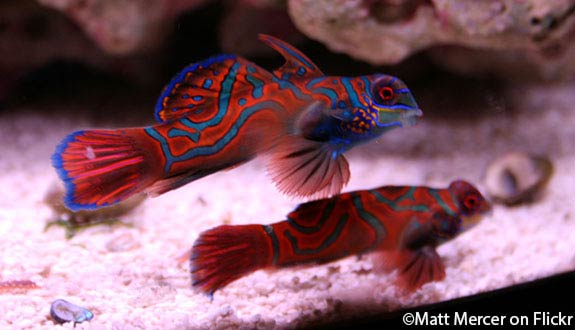
Finally, note that an aquarium that is very rich in zooplankton will encourage individuals to live together without fear of food competition.
Of a slightly shy nature, avoid associating the Mandarin with large territorial or aggressive fish. Don't forget that the more spacious an aquarium is, the more the different species will be able to juxtapose their territories: cohabitation will only be easier.
It is beneficial to associate them with sea urchins (Diadema setosum) because Mandarins like to hide between their long quills.
Breeding
How to breed the Mandarin dragonet?
Breeding
How to breed the Mandarin dragonet?
Forming a couple will not be a problem (even if it can be difficult to find a female, as most Mandarin Fish sold are males): dimorphism is obvious and in most cases, the mere presence of individuals of both sexes is enough to form a couple suitable for reproduction. It is still necessary that the individuals present are not starving!
The protocol for fish to spawn is not very difficult. On the other hand, rearing fry in captivity is very, very difficult, mainly because of feeding. It will require large facilities and a lot of patience!
Its aquarium
Which aquarium for the Mandarin dragonet?
Its aquarium
Which aquarium for the Mandarin dragonet?
You can introduce the Mandarin into a reef aquarium with a large amount of live rocks and corals. It will appreciate the presence of many hiding places and crevices among the rocks, especially near the bottom of the aquarium. Finally, a sandy floor will be perfect to remind him of his original biotope.
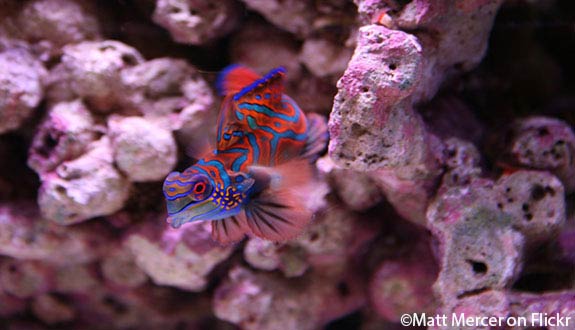
Wait at least a few months after your aquarium has been filled with water before introducing your Mandarins. You will have to wait at least 6 to 8 months or more. Indeed, as they eat the micro fauna (the animalcules, see "feeding"), colonies of these small animals must already be well installed in your aquarium!
Good To know
Find all additional information!
Good To know
Find all additional information!
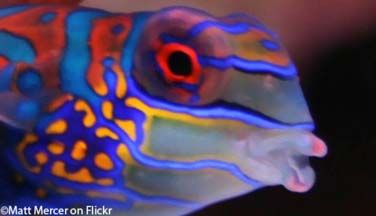
It dislodges the microscopic animals it feeds on using its tweeze-shaped mouth, which it can stretch forward (protractile).
When buying a fish, make sure that the fish you choose has a well rounded belly. This is because many Mandarins are very malnourished and have a hollow belly. It can therefore be difficult to "catch up" with their slimmed down fish.
Interesting fact: it has no scales! On the other hand, its skin secretes toxins. Its beautiful coloration would in fact be a warning signal for its predators indicating its toxicity!
It can sometimes be confused with Synchiropus picturatus, but on closer inspection, its oval patterns distinguish it perfectly from our Mandarin!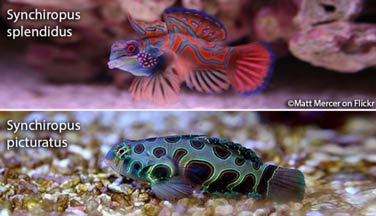
Its French name "Mandarin" reminds us of the colourful clothing of the Chinese Mandarins. As for the "splendidus" of its scientific name, we let you admire this photo to put you on the track of its meaning: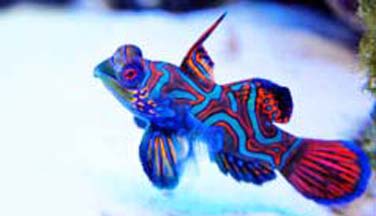
Yours photos!

By Encyclo-Caro
Comments
Sort by:
Please login to post comments
